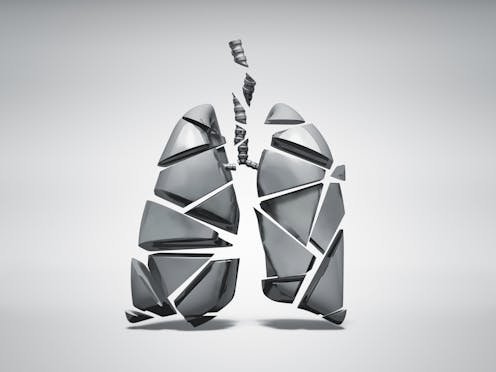Iron fuels immune cells – and it could make asthma worse
Asthma attacks can result from immune cells overreacting to a harmless allergen. Tamping down iron levels in certain immune cells can help control their activity.

You’ve likely heard that you can get iron from eating spinach and steak. You might also know that it’s an essential trace element that is a major component of hemoglobin, a protein in red blood cells that carries oxygen from your lungs to all parts of the body.
A lesser known important function of iron is its involvement in generating energy for certain immune cells.
In our lab’s newly published research, we found that blocking or limiting iron uptake in immune cells could potentially ease up the symptoms of an asthma attack caused by allergens.
Immune cells that need iron
During an asthma attack, harmless allergens activate immune cells in your lungs called ILC2s. This causes them to multiply and release large amounts of cytokines – messengers that immune cells use to communicate – and leads to unwanted inflammation. The result is symptoms such as coughing and wheezing that make it feel like someone is squeezing your airways.
To assess the role iron plays in how ILC2s function in the lungs, we conducted a series of experiments with ILC2s in the lab. We then confirmed our findings in mice with allergic asthma and in patients with different severities of asthma.
First, we found that ILC2s use a protein called transferrin receptor 1, or TfR1, to take up iron. When we blocked this protein as the ILC2s were undergoing activation, the cells were unable to use iron and could no longer multiply and cause inflammation as well as they did before.
We then used a chemical called an iron chelator to prevent ILC2s from using any iron at all. Iron chelators are like superpowered magnets for iron and are used in medical treatments to help manage conditions where there’s too much iron in the body.
When we deprived ILC2s with an iron chelator, the cells had to change their metabolism and switch to a different way of getting energy, like trading in a sports car for a bicycle. The cells weren’t as effective at causing inflammation in the lungs anymore.

Next, we limited cellular iron in mice with sensitive airways due to ILC2s. We did this in three different ways: by inhibiting TfR1, adding an iron chelator or inducing low overall iron levels using a synthetic protein called mini-hepcidin. Each of these methods helped reduce the mice’s airway hyperreactivity – basically reducing the severity of their asthma symptoms.
Lastly, we looked at cells from patients with asthma. We noticed something interesting: the more TfR1 protein on their ILC2 cells, the worse their asthma symptoms. In other words, iron was playing a big role in how bad their asthma got. Blocking TfR1 and administering iron chelators both reduced ILC2 proliferation and cytokine production, suggesting that our findings in mice apply to human cells. This means we can move these findings from the lab to clinical trials as quickly as possible.
Iron therapy for asthma
Iron is like the conductor of an orchestra, instructing immune cells such as ILC2s how to behave during an asthma attack. Without enough iron, these cells can’t cause as much trouble, which could mean fewer asthma symptoms.
Next, we’re working on targeting a patient’s immune cells during an asthma attack. If we can lower the amount of iron available to ILC2s without depleting overall iron levels in the body, this could mean a new therapy for asthma that tackles the root cause of the disease, not just the symptoms. Available treatments can control symptoms to keep patients alive, but they are not curing the disease. Iron-related therapies may offer a better solution for patients with asthma.
Our discovery applies to more than just asthma. It could be a game-changer for other diseases where ILC2s are involved, such as eczema and type 2 diabetes. Who knew iron could be such a big deal to your immune system?
Omid Akbari receives funding from NIH.
Benjamin Hurrell does not work for, consult, own shares in or receive funding from any company or organization that would benefit from this article, and has disclosed no relevant affiliations beyond their academic appointment.
Read These Next
From record warming to rusting rivers, 2025 Arctic Report Card shows a region transforming faster th
The 20th anniversary of the annual report tracks how sea ice, snow cover and many other vital signs…
The North Pole keeps moving – here’s how that affects Santa’s holiday travel and yours
There are actually two North Poles. One has been wandering over northern Canada and north of there for…
2 superpowers, 1 playbook: Why Chinese and US bureaucrats think and act alike
The men and women tasked with implementing policy are governed by the same incentives and constraints…





